Читать книгу The Essential Fishing Handbook - Joe Cermele - Страница 43
На сайте Литреса книга снята с продажи.
Оглавление30
29
Practice AnimalMagnetism
The long, flexible hair from a deer’s tail is widely used in making bucktail jigs as well as streamer flies like the Clouser Deep Minnow. Deer body hair, meanwhile, is shorter, stiffer, and hollow. It can be spun around a hook shank with thread and trimmed to make floating bass bugs. In either case, you can have the satisfaction of catching fish with lures and flies made from your own trophy, if you happen to hunt. Here’s a quick cut to get you there.
CUT AND CURE Start with a fresh deer tail cut at its base from the hide. Slice open the hide to expose the tailbone and remove the bone, starting at the base and working on the underside. Scrape away as much fat and tissue as possible. To get the right deer body hair, cut a few hide pieces about x inches (x cm)in both white (belly) and brown (back or side) shades, and scrape. Coat the scraped hide with salt and allow to cure, which will take a few days.
COLORS TO DYE FOR Aer the hide dries, gently wash bucktail or body-hair patches in lukewarm water, using a standard household detergent. Rinse thoroughly to get rid of grease and grit. Air-dry the hair, unless you plan to dye it, in which case keep it wet while you ready a dye bath. Deer hair is easily colored with common fabric dyes such as Rit or Tintex. Believe it or not, one of the best dyes to use for some colors such as orange or purple is unsweetened Kool-Aid. The most useful color for both flies and jigs is natural white; save at least one tail without dyeing it. For, say, smallmouth bass jigs, you’ll probably want to dye some tails in green, brown, and orange so your jigs will imitate crayfish.
Making a bucktail jig is easy. Clamp a jighead
by the hook bend in a
fly-tying vise or locking pliers. Fasten somefly-tying or polyester sewing thread right behind the jighead. Separate and grab a 1⁄8-inch-diameter ( mm) clump of white bucktail with your thumb and index finger. Cut this clump at the base of the fibers. Hold it next to
the jig—hair tips to the rear—to gauge desired hair length, then trim the bus accordingly. Now hold the clump so bus are just behind the jighead and secure bu ends of the hair fibers to the hook shank with six to eight tight turns of thread to anchor the hairs onto the hook. Continue adding clumps of hair all the way around the jig. Finish with a whip-finish knot or a few half-hitch knots. Finally, coat the thread wraps with some hard-finish nail polish.
JIG YOURBUCK
A
B
C
D
E
TROPHY BUCKTAILS:(A) Bucktail jig;(B) Mickey fin;(C) Frankie Shiner;(D) Hot Lips saltwater jig;
(E) Clouser Minnow
